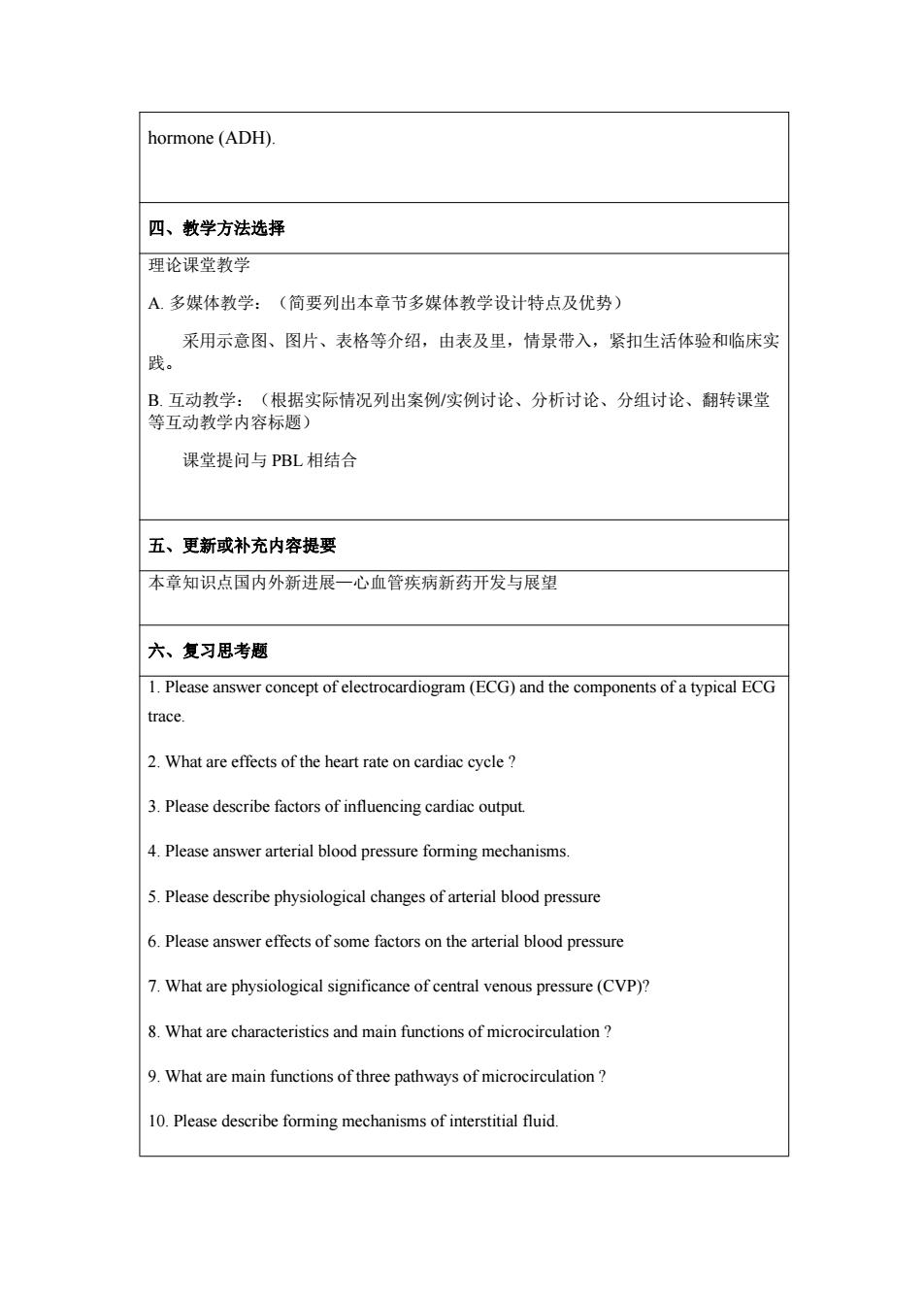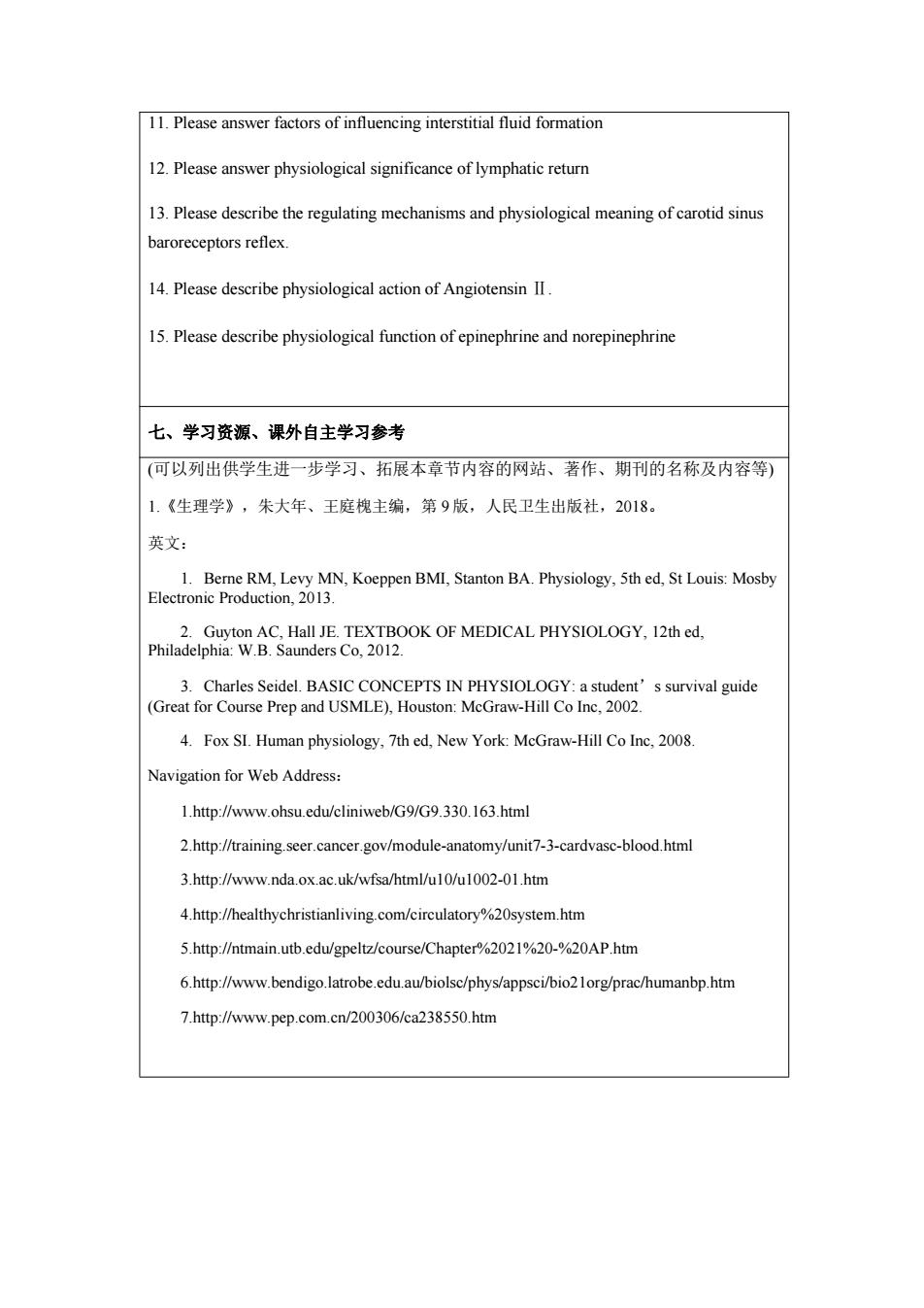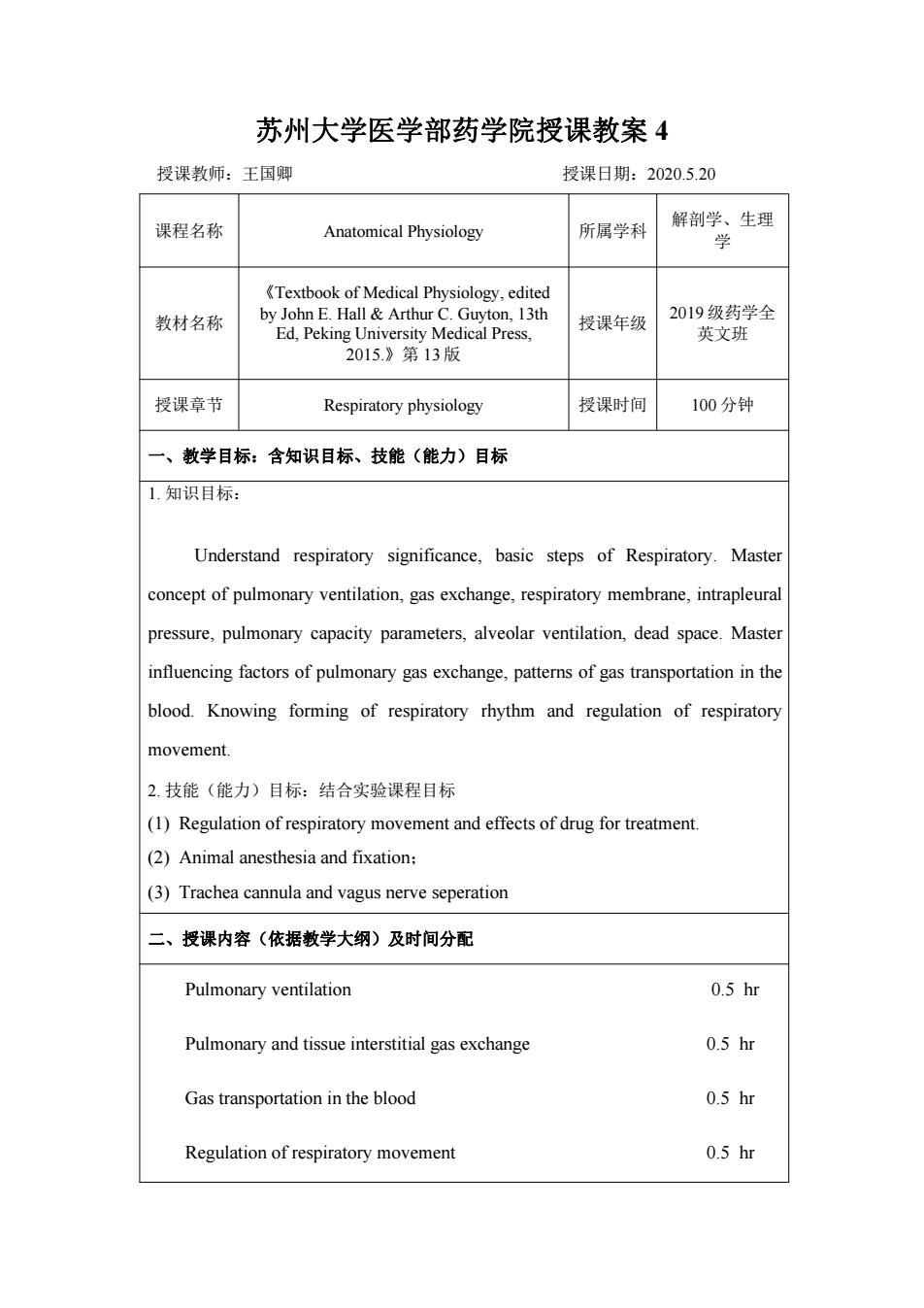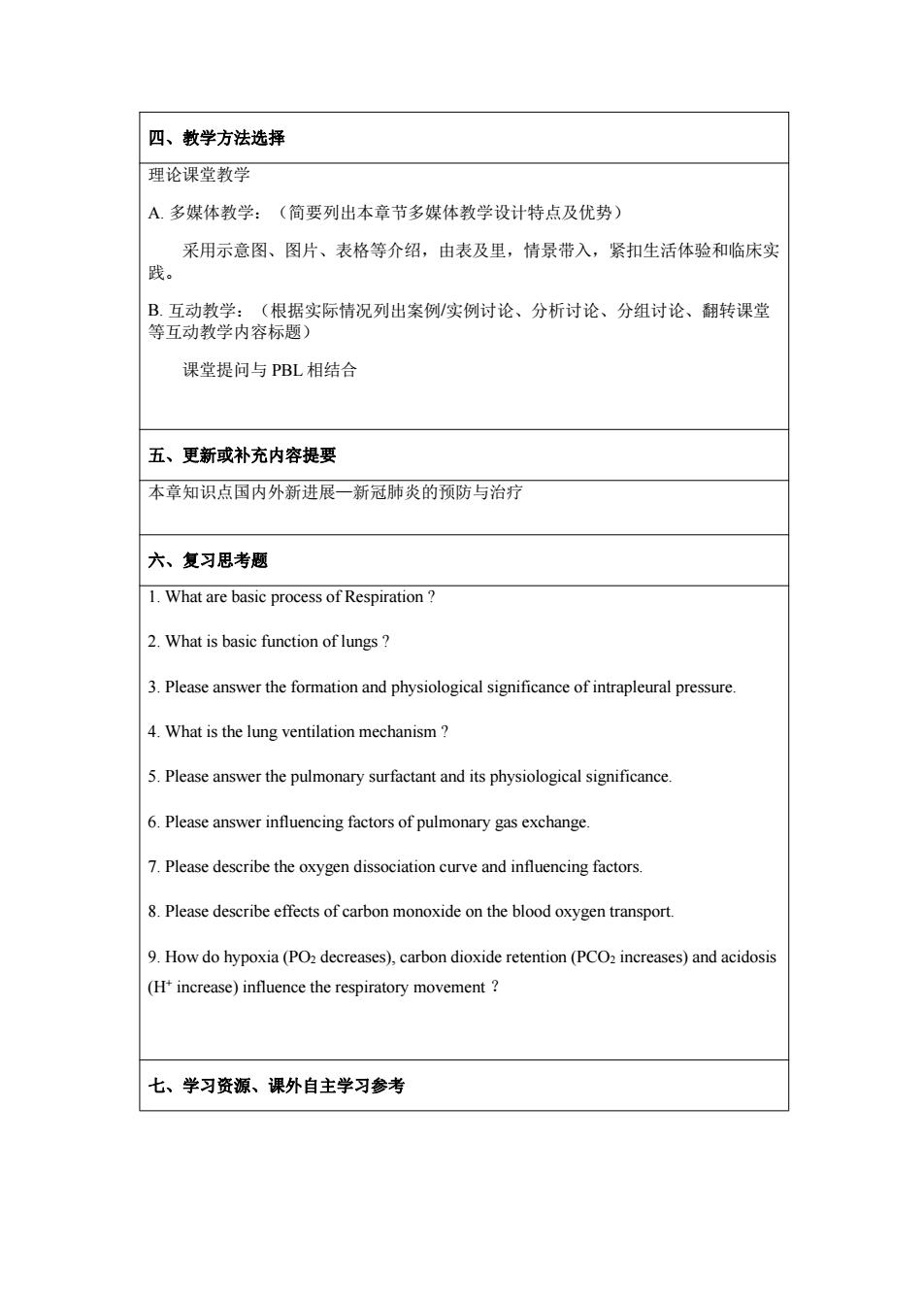
hormone(ADH). 四、教学方法选择 理论课堂教学 A.多媒体教学:(简要列出本章节多媒体教学设计特点及优势) 采用示意图、图片、表格等介绍,由表及里,情景带入,紧扣生活体验和临床实 践。 B.互动教学:(根据实际情况列出案例/实例讨论、分析讨论、分组讨论、翻转课堂 等互动教学内容标题) 课堂提问与PBL相结合 五、更新或补充内容提要 本章知识点国内外新进展一心血管疾病新药开发与展望 六、复习思考题 1.Please answer concept of electrocardiogram(ECG)and the components of a typical ECG trace. 2.What are effects of the heart rate on cardiac cycle 3.Please describe factors of influencing cardiac output. 4.Please answer arterial blood pressure forming mechanisms. 5.Please describe physiological changes of arterial blood pressure 6.Please answer effects of some factors on the arterial blood pressure 7.What are physiological significance of central venous pressure(CVP)? 8.What are characteristics and main functions of microcirculation 9.What are main functions of three pathways of microcirculation? 10.Please describe forming mechanisms of interstitial fluid
hormone (ADH). 四、教学方法选择 理论课堂教学 A. 多媒体教学:(简要列出本章节多媒体教学设计特点及优势) 采用示意图、图片、表格等介绍,由表及里,情景带入,紧扣生活体验和临床实 践。 B. 互动教学:(根据实际情况列出案例/实例讨论、分析讨论、分组讨论、翻转课堂 等互动教学内容标题) 课堂提问与 PBL 相结合 五、更新或补充内容提要 本章知识点国内外新进展—心血管疾病新药开发与展望 六、复习思考题 1. Please answer concept of electrocardiogram (ECG) and the components of a typical ECG trace. 2. What are effects of the heart rate on cardiac cycle ? 3. Please describe factors of influencing cardiac output. 4. Please answer arterial blood pressure forming mechanisms. 5. Please describe physiological changes of arterial blood pressure 6. Please answer effects of some factors on the arterial blood pressure 7. What are physiological significance of central venous pressure (CVP)? 8. What are characteristics and main functions of microcirculation ? 9. What are main functions of three pathways of microcirculation ? 10. Please describe forming mechanisms of interstitial fluid

11.Please answer factors of influencing interstitial fluid formation 12.Please answer physiological significance of lymphatic return 13.Please describe the regulating mechanisms and physiological meaning of carotid sinus baroreceptors reflex. 14.Please describe physiological action of Angiotensin II. 15.Please describe physiological function of epinephrine and norepinephrine 七、学习资源、课外自主学习参考 (可以列出供学生进一步学习、拓展本章节内容的网站、著作、期刊的名称及内容等) 1.《生理学》,朱大年、王庭槐主编,第9版,人民卫生出版社,2018。 英文: 1.Berne RM,Levy MN,Koeppen BMI,Stanton BA.Physiology,5th ed,St Louis:Mosby Electronic Production,2013. 2.Guyton AC,Hall JE.TEXTBOOK OF MEDICAL PHYSIOLOGY,12th ed, Philadelphia:W.B.Saunders Co,2012. 3.Charles Seidel.BASIC CONCEPTS IN PHYSIOLOGY:a student's survival guide (Great for Course Prep and USMLE),Houston:McGraw-Hill Co Inc,2002. 4.Fox SI.Human physiology,7th ed,New York:McGraw-Hill Co Inc,2008. Navigation for Web Address: 1.http://www.ohsu.edu/cliniweb/G9/G9.330.163.html 2.http://training.seer.cancer.gov/module-anatomy/unit7-3-cardvasc-blood.html 3.http://www.nda.ox.ac.uk/wfsa/htmI/ul0/ul002-01.htm 4.http://healthychristianliving.com/circulatory%20system.htm 5.http://ntmain.utb.edu/gpeltz/course/Chapter%2021%20-%20AP.htm 6.http://www.bendigo.latrobe.edu.au/biolsc/phys/appsci/bio21org/prac/humanbp.htm 7.http://www.pep.com.cn/200306/ca238550.htm
11. Please answer factors of influencing interstitial fluid formation 12. Please answer physiological significance of lymphatic return 13. Please describe the regulating mechanisms and physiological meaning of carotid sinus baroreceptors reflex. 14. Please describe physiological action of Angiotensin Ⅱ. 15. Please describe physiological function of epinephrine and norepinephrine 七、学习资源、课外自主学习参考 (可以列出供学生进一步学习、拓展本章节内容的网站、著作、期刊的名称及内容等) 1.《生理学》,朱大年、王庭槐主编,第 9 版,人民卫生出版社,2018。 英文: 1. Berne RM, Levy MN, Koeppen BMI, Stanton BA. Physiology, 5th ed, St Louis: Mosby Electronic Production, 2013. 2. Guyton AC, Hall JE. TEXTBOOK OF MEDICAL PHYSIOLOGY, 12th ed, Philadelphia: W.B. Saunders Co, 2012. 3. Charles Seidel. BASIC CONCEPTS IN PHYSIOLOGY: a student’s survival guide (Great for Course Prep and USMLE), Houston: McGraw-Hill Co Inc, 2002. 4. Fox SI. Human physiology, 7th ed, New York: McGraw-Hill Co Inc, 2008. Navigation for Web Address: 1.http://www.ohsu.edu/cliniweb/G9/G9.330.163.html 2.http://training.seer.cancer.gov/module-anatomy/unit7-3-cardvasc-blood.html 3.http://www.nda.ox.ac.uk/wfsa/html/u10/u1002-01.htm 4.http://healthychristianliving.com/circulatory%20system.htm 5.http://ntmain.utb.edu/gpeltz/course/Chapter%2021%20-%20AP.htm 6.http://www.bendigo.latrobe.edu.au/biolsc/phys/appsci/bio21org/prac/humanbp.htm 7.http://www.pep.com.cn/200306/ca238550.htm

苏州大学医学部药学院授课教案4 授课教师:王国卿 授课日期:2020.5.20 解剖学、生理 课程名称 Anatomical Physiology 所属学科 学 Textbook of Medical Physiology,edited 教材名称 by John E.Hall Arthur C.Guyton,13th 授课年级 2019级药学全 Ed,Peking University Medical Press, 英文班 2015.》第13版 授课章节 Respiratory physiology 授课时间 100分钟 一、教学目标:含知识目标、技能(能力)目标 1.知识目标: Understand respiratory significance,basic steps of Respiratory.Master concept of pulmonary ventilation,gas exchange,respiratory membrane,intrapleural pressure,pulmonary capacity parameters,alveolar ventilation,dead space.Master influencing factors of pulmonary gas exchange,patterns of gas transportation in the blood.Knowing forming of respiratory rhythm and regulation of respiratory movement 2.技能(能力)目标:结合实验课程目标 (1)Regulation of respiratory movement and effects of drug for treatment. (2)Animal anesthesia and fixation: (3)Trachea cannula and vagus nerve seperation 二、授课内容(依据教学大纲)及时间分配 Pulmonary ventilation 0.5hr Pulmonary and tissue interstitial gas exchange 0.5hr Gas transportation in the blood 0.5hr Regulation of respiratory movement 0.5hr
苏州大学医学部药学院授课教案 4 授课教师:王国卿 授课日期:2020.5.20 课程名称 Anatomical Physiology 所属学科 解剖学、生理 学 教材名称 《Textbook of Medical Physiology, edited by John E. Hall & Arthur C. Guyton, 13th Ed, Peking University Medical Press, 2015.》第 13 版 授课年级 2019 级药学全 英文班 授课章节 Respiratory physiology 授课时间 100 分钟 一、教学目标:含知识目标、技能(能力)目标 1. 知识目标: Understand respiratory significance, basic steps of Respiratory. Master concept of pulmonary ventilation, gas exchange, respiratory membrane, intrapleural pressure, pulmonary capacity parameters, alveolar ventilation, dead space. Master influencing factors of pulmonary gas exchange, patterns of gas transportation in the blood. Knowing forming of respiratory rhythm and regulation of respiratory movement. 4. 2. 技能(能力)目标:结合实验课程目标 (1) Regulation of respiratory movement and effects of drug for treatment. (2) Animal anesthesia and fixation; (3) Trachea cannula and vagus nerve seperation 二、授课内容(依据教学大纲)及时间分配 Pulmonary ventilation 0.5 hr Pulmonary and tissue interstitial gas exchange 0.5 hr Gas transportation in the blood 0.5 hr Regulation of respiratory movement 0.5 hr

三、教学重点与难点 1.教学重点 Respiratory significance:Basic steps of Respiratory Pulmonary ventilation:structure and function of pulmonary ventilation, respiratory tract,pulmonary alveoli and respiratory membrane;Alveolar surfactant and its function;Changes in intrapulmonary pressure and intrapleural pressure during respiration;Forming of intrapleural pressure;Action of alveolar surfactant; Pulmonary capacity Pulmonary ventilation volume(minute pulmonary ventilation volume,maximal voluntary ventilation (MVV),alveolar ventilation and dead space (DS). Mechanism of respiratory gas exchange and influencing factors of gas exchange (gas spreading rate,respiratory membrane and ventilation perfusion ratio). Gas transportation in the blood cyanosis;Oxygen dissociation curve and its influencing factors;Carbon dioxide dissociation curve and its influencing factors. Regulation of respiratory movement. 2.教学难点 Respiratory center,relative localization of respiratory neuron in the medullary respiratory center.Reflex regulation of respiration,pulmonary stretch reflex and functional significance,proprioceptive reflex of respiratory muscle and its significance;Chemical regulation of respiration (peripheral chemoreceptor and central chemoreceptor,effects of partial pressure of carbon dioxide,hydrogen ion concentration and partial pressure of oxygen in the arterial blood on respiratory movement
三、教学重点与难点 1. 教学重点 Respiratory significance;Basic steps of Respiratory ; Pulmonary ventilation: structure and function of pulmonary ventilation, respiratory tract, pulmonary alveoli and respiratory membrane; Alveolar surfactant and its function; Changes in intrapulmonary pressure and intrapleural pressure during respiration; Forming of intrapleural pressure; Action of alveolar surfactant; Pulmonary capacity ; Pulmonary ventilation volume (minute pulmonary ventilation volume, maximal voluntary ventilation (MVV), alveolar ventilation and dead space (DS).Mechanism of respiratory gas exchange and influencing factors of gas exchange (gas spreading rate, respiratory membrane and ventilation / perfusion ratio). Gas transportation in the blood ; cyanosis; Oxygen dissociation curve and its influencing factors; Carbon dioxide dissociation curve and its influencing factors. Regulation of respiratory movement. 2. 教学难点 Respiratory center, relative localization of respiratory neuron in the medullary respiratory center. Reflex regulation of respiration, pulmonary stretch reflex and functional significance, proprioceptive reflex of respiratory muscle and its significance; Chemical regulation of respiration (peripheral chemoreceptor and central chemoreceptor, effects of partial pressure of carbon dioxide, hydrogen ion concentration and partial pressure of oxygen in the arterial blood on respiratory movement

四、教学方法选择 理论课堂教学 A.多媒体教学:(简要列出本章节多媒体教学设计特点及优势) 采用示意图、图片、表格等介绍,由表及里,情景带入,紧扣生活体验和临床实 践。 B.互动教学:(根据实际情况列出案例/实例讨论、分析讨论、分组讨论、翻转课堂 等互动教学内容标题) 课堂提问与PBL相结合 五、更新或补充内容提要 本章知识点国内外新进展一新冠肺炎的预防与治疗 六、复习思考题 1.What are basic process of Respiration 2.What is basic function of lungs 3.Please answer the formation and physiological significance of intrapleural pressure. 4.What is the lung ventilation mechanism 5.Please answer the pulmonary surfactant and its physiological significance. 6.Please answer influencing factors of pulmonary gas exchange. 7.Please describe the oxygen dissociation curve and influencing factors. 8.Please describe effects of carbon monoxide on the blood oxygen transport. 9.How do hypoxia(PO2 decreases),carbon dioxide retention(PCO2 increases)and acidosis (H'increase)influence the respiratory movement 七、学习资源、课外自主学习参考
四、教学方法选择 理论课堂教学 A. 多媒体教学:(简要列出本章节多媒体教学设计特点及优势) 采用示意图、图片、表格等介绍,由表及里,情景带入,紧扣生活体验和临床实 践。 B. 互动教学:(根据实际情况列出案例/实例讨论、分析讨论、分组讨论、翻转课堂 等互动教学内容标题) 课堂提问与 PBL 相结合 五、更新或补充内容提要 本章知识点国内外新进展—新冠肺炎的预防与治疗 六、复习思考题 1. What are basic process of Respiration ? 2. What is basic function of lungs ? 3. Please answer the formation and physiological significance of intrapleural pressure. 4. What is the lung ventilation mechanism ? 5. Please answer the pulmonary surfactant and its physiological significance. 6. Please answer influencing factors of pulmonary gas exchange. 7. Please describe the oxygen dissociation curve and influencing factors. 8. Please describe effects of carbon monoxide on the blood oxygen transport. 9. How do hypoxia (PO2 decreases), carbon dioxide retention (PCO2 increases) and acidosis (H+ increase) influence the respiratory movement ? 七、学习资源、课外自主学习参考